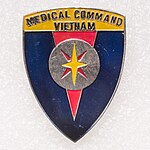
The 1st Theater Sustainment Command is a major subordinate unit of United States Army Central at Fort Knox, Kentucky, United States.

United States Army Republic of Vietnam (USARV) was a corps-level support command of the United States Army in the Vietnam War.

The 5th Signal Command (Theater) ("Dragon Warriors") was a European-based tactical and strategic communications organization of the United States Army specializing in command and control which supported theater-limited, joint-forces, and combined forces activities. The command's mission was to build, operate and defend network capabilities to enable mission command and create tactical, operational and strategic flexibility for Army, Joint and Multinational forces in the EUCOM and AFRICOM areas of responsibility.

This article incorporates public domain material from websites or documents of the United States Army.
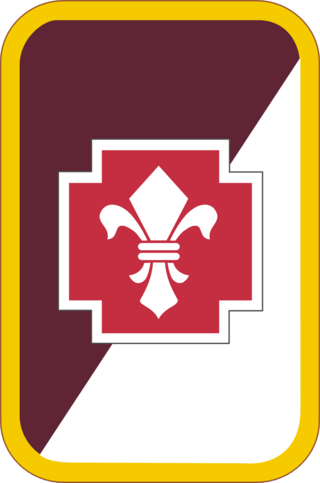
The 62nd Medical Brigade, formerly the 62nd Medical Group of the United States Army is a unit of the Army Medical Department and I Corps and Fort Lewis. It is based entirely at Joint Base Lewis-McChord, Washington. Currently, the brigade is commanded by Colonel Yolonda “Y. R.” Summons and Command Sergeant Major Meaux.

The 9th Army Signal Command is the operational executive agent for Army-wide network operations and security. It is the single point of contact for Army network development and protection, providing C4 information management of common-user services in support of the combatant commanders and Army service component commanders. It was the numbered command for the Network Enterprise Technology Command.
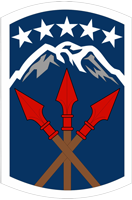
The 593rd Expeditionary Sustainment Command is a Sustainment Command of the United States Army.

This article incorporates public domain material from websites or documents of the United States Army.

The 3rd Medical Command (Deployment Support) (MCDS) or "Desert Medics" is headquartered in Atlanta, GA and manages all the Army Reserve deployable field medical units east of Ohio. While the 807th MCDS covers the MTOE medical units to the west and ARMEDCOM provides command and control for all the Table of Distribution and Allowance (TDA) medical units within CONUS.

The 3rd Expeditionary Sustainment Command is a United States Army unit. It derives its lineage from the 3rd Logistical Command, which was activated in Japan on 19 September 1950 for service in Korea.
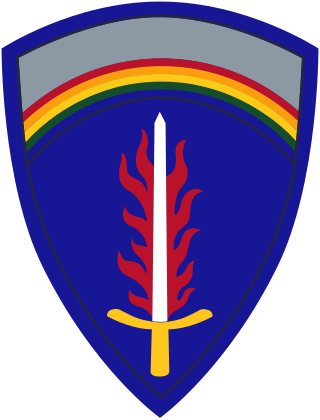
United States Army Europe and Africa (USAREUR-AF) is an Army Service Component Command (ASCC) /Theater Army responsible for directing United States Army operations throughout the U.S. European Command (EUCOM) and U.S. Africa Command (AFRICOM) area of responsibility.

The 14th Combat Support Hospital is a combat support hospital of the United States Army. It participated in World War II, the Korean War and, more recently, deployed to Afghanistan. The hospital was involved in relief operations following Hurricane Katrina. The unit currently falls under the command of the 44th Medical Brigade and is based at Fort Benning, GA, and relocating to Fort Stewart, GA during FY 2020.

The 525th Expeditionary Military Intelligence Brigade (Expeditionary) is a unit of the United States Army specializing in the acquisition and analysis of information with potential military value. On 28 October 2014, the unit was reflagged from the "525th Battlefield Surveillance Brigade" to an expeditionary military intelligence brigade, the first of its kind.

Long Binh Post is a former U.S. Army base located in Long Bình, Đồng Nai between Biên Hòa and Saigon, Vietnam. The base functioned as a U.S. Army base, logistics center, and major command headquarters for United States Army Vietnam (USARV). Long Binh Post was also unofficially known as "Long Binh Junction, influenced by the widely used initials of then-President Lyndon B. Johnson.

The 326th Medical Battalion was a divisional support medical unit of the United States Army. It supported the 101st Airborne Division, located at Fort Campbell, Kentucky. Its lineage and honors are perpetuated by the 626th Support Battalion, 101st Airborne Division, Fort Campbell, Kentucky.

The 261st Medical Battalion is a Multifunctional Medical Battalion of the US Army located at Fort Bragg, North Carolina, under the command and control of the 44th Medical Brigade. It provides a flexible and modular medical battle command, administrative assistance, logistical support, and technical supervision capability for assigned and attached medical organizations, which can be task-organized to support deployed forces.

The 68th Medical Group was constituted on 18 October 1927 in the Regular Army as the 18th Medical Regiment. Redesignated as the 68th Medical Regiment and reorganized as the 68th Medical Group, the organization served in combat in Europe in World War II and in the Republic of Vietnam. During the Cold War, it was stationed at Fort George G. Meade, Maryland from 1954 until its deployment to Vietnam and was reactivated again in Germany, where it served from 1978 into the 1990s.
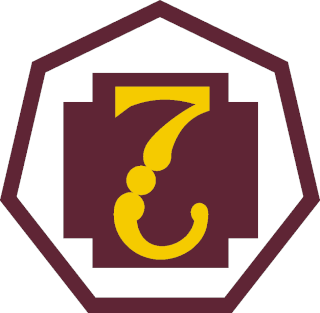
The 7th Medical Command provided Echelon/Role 4 Health Service Support to units of the United States Army Europe. It was a Table of organization and equipment organization that replaced the United States Army Medical Command, Europe, a Table of distribution and allowances-based organization that had provided both Role 3 and Role 4 Health Service Support from 1970 to 1978. Upon the inactivation of the 7th Medical Command in 1994, the Role 4 mission was assumed by the United States Army Medical Command through its European Health Service Support Area, while the remaining Role 3 mission was assumed by the 30th Medical Brigade.

The United States Army Medical Command, Europe (USAMEDCOMEUR) provided Echelon/Roles 3 and 4 Health Service Support to units of the United States Army Europe. It was a Table of Distribution and Allowances organization that consolidated Role 3 and 4 Health Service Support under a single command. Upon the inactivation of the United States Army Medical Command, Europe in 1978, the Role 4 mission was assumed by the 7th Medical Command, while the Role 3 mission was assumed by the 68th Medical Group in support of the V Corps and the 30th Medical Group in support of the VII Corps.

This article incorporates public domain material from websites or documents of the United States Army.




